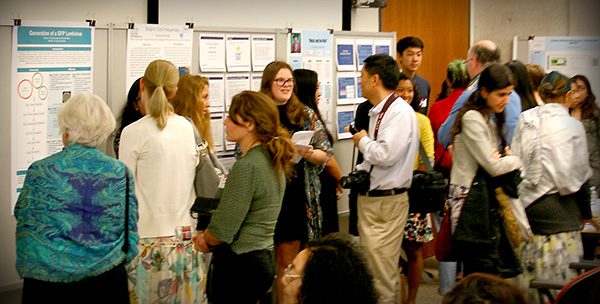

 Skip to navigation
Skip to navigation
Site Primary Navigation:
- About SDSC
- Services
- Support
- Research & Development
- Education & Training
- News & Events
Search The Site:

Published June 27, 2016

The San Diego Supercomputer Center (SDSC) at the University of California San Diego, in collaboration with the UC San Diego Division of Health Sciences, is preparing to launch the second year of a new mentoring program designed to provide a pathway for high school students to gain access to experts in their field of interest.
The first phase of the Mentor Assistance Program (MAP), co-founded by Ange Mason, SDSC’s education program manager, and Kellie Church, assistant professor in the Department of Reproductive Medicine within UC San Diego’s School of Medicine, was recently celebrated at a symposium at SDSC. The event drew almost 300 guests, including school district administrators, principals, and teachers as well as parents and family members of students. The first phase of the MAP program ran from November 2015 through May of this year.
MAP is focused on creating mentoring relationships that will enhance students’ desire to learn, teach, and conduct research in a variety of fields, including science, technology, engineering, and mathematics, or what’s referred to as STEM. During its inaugural year, the MAP program included 77 students from 33 high schools who were accepted out of 225 applications, 34 mentors from 24 UC San Diego campus departments, and 65 students presented 48 projects at the symposium.
In late 2014, SDSC’s Mason and Health Sciences’ Church began discussing the feasibility of a long-term mentoring program for high school students that would give underserved students initial access to UC San Diego researchers, thereby giving them a way to pursue a career of their choice. One goal was to ensure that the program provided a good degree of flexibility for faculty, post docs, and staff as mentors, who typically have very busy schedules. Another was to make the program a rewarding experience for high school students across San Diego County.
“We carefully designed this program so the mentors could decide their own level of involvement with the students, and provide alternatives such as mentoring via email and phone, or mentoring at laboratory or worksite visits,” said SDSC’s Mason. “As a culmination of all of our work to date, the recent symposium was one of the proudest moments of my professional career. Some 90 percent of the students said they would return if given the opportunity, and half of them were offered summer internships, giving them the opportunity to continue their research experience throughout the summer.”
“The impact of the MAP program became utterly clear at the Symposium where not only students, but parents, teachers, principals, and even superintendents, repeatedly stated that this program has made a significant impact in students’ lives,” said Church.
“The MAP program was simply phenomenal,” said participant Zoe Smith, who attends one of San Diego’s High Tech High schools. “Along with learning computer science content, I was able to communicate with different people in order to work toward a finished project. My mentor was awesome, my teammate was great, and our final product was a success. I could not have asked for a better experience!”
Daniel Shevchuk, who attends Del Norte High School, part of the Poway Unified School District, worked with UC San Diego Professor Christine Hunefeldt in the university’s History Department. He and fellow interns AJ Maloney and Tyler Satoda studied the European exploration of the Amazon Rainforest. “I've never listened to deeper and more meaningful conversations than in this internship,” said Shevchuk. “Thank you MAP!”
The second year of the MAP program was announced to UC San Diego faculty, postdocs and staff earlier this month. Mentors interested in participating have until July 1 to file their applications. The MAP application process opens to high school students in grades 11 and 12 on September 1, with a deadline of September 30, 2016.
Almost all of the UC San Diego mentors are returning to participate in MAP’s next program, which will run from November 2016 to May 2017, said Mason. “We look forward to welcoming them back to help us give our students an amazing experience as they look ahead to completing their education and making some well-informed career choices.”
The symposium event included a keynote address by Karen Flammer, SDSC’s Education Director and co-founder of Sally Ride Science. “As educators, we also know that the most successful people tend to be life-long learners who build multiple skill sets, such as combining expertise in science, the arts, history, and sports,” said Flammer. “Congratulations to all the students and mentors for their exceptional efforts this year, as we kick off MAP’s second year in the coming months.”
Full details on becoming a MAP mentor and applications for download can be accessed here. Information specific to students will be posted on August 1, 2016.
About SDSC
As an Organized Research Unit of UC San Diego, SDSC is considered a leader in data-intensive computing and cyberinfrastructure, providing resources, services, and expertise to the national research community, including industry and academia. Cyberinfrastructure refers to an accessible, integrated network of computer-based resources and expertise, focused on accelerating scientific inquiry and discovery. SDSC supports hundreds of multidisciplinary programs spanning a wide variety of domains, from earth sciences and biology to astrophysics, bioinformatics, and health IT. SDSC’s Comet joins the Center’s data-intensive Gordon cluster, and are both part of the National Science Foundation’s XSEDE (eXtreme Science and Engineering Discovery Environment) program, the most advanced collection of integrated digital resources and services in the world.
Share